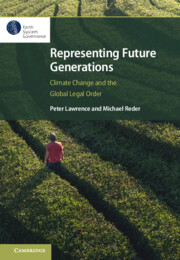Refine search
Actions for selected content:
2077 results
5 - Lessons from Existing International Institutions to Represent Vulnerable Groups
- from Part II - International Law and Institutions
-
- Book:
- Representing Future Generations
- Published online:
- 19 September 2025
- Print publication:
- 09 October 2025, pp 116-142
-
- Chapter
- Export citation
4 - Criteria for Evaluating Mechanisms for Representation of Future Generations
- from Part II - International Law and Institutions
-
- Book:
- Representing Future Generations
- Published online:
- 19 September 2025
- Print publication:
- 09 October 2025, pp 93-115
-
- Chapter
- Export citation
4 - Climate and the Atmosphere
-
- Book:
- International Environmental Law
- Published online:
- 19 September 2025
- Print publication:
- 09 October 2025, pp 115-164
-
- Chapter
- Export citation
3 - Functions and Foundations of International Environmental Law
-
- Book:
- International Environmental Law
- Published online:
- 19 September 2025
- Print publication:
- 09 October 2025, pp 77-114
-
- Chapter
- Export citation
8 - A UN Special Envoy for Future Generations
- from Part III - Case Studies
-
- Book:
- Representing Future Generations
- Published online:
- 19 September 2025
- Print publication:
- 09 October 2025, pp 200-219
-
- Chapter
- Export citation
6 - The ICJ Advisory Opinion on Climate Change and Proxy Representation of Future Generations
- from Part III - Case Studies
-
- Book:
- Representing Future Generations
- Published online:
- 19 September 2025
- Print publication:
- 09 October 2025, pp 145-177
-
- Chapter
- Export citation
Introduction
-
- Book:
- International Environmental Law
- Published online:
- 19 September 2025
- Print publication:
- 09 October 2025, pp xxxvi-7
-
- Chapter
- Export citation
Introduction
-
- Book:
- Burning Swamps
- Published online:
- 06 September 2025
- Print publication:
- 25 September 2025, pp 1-24
-
- Chapter
- Export citation
5 - Irritation
- from Part III - Unsettling Environments: Threat, Loss, and Precarity in Russia’s Peatlands
-
- Book:
- Burning Swamps
- Published online:
- 06 September 2025
- Print publication:
- 25 September 2025, pp 171-197
-
- Chapter
- Export citation
Conclusions
-
- Book:
- Burning Swamps
- Published online:
- 06 September 2025
- Print publication:
- 25 September 2025, pp 231-236
-
- Chapter
- Export citation

Representing Future Generations
- Climate Change and the Global Legal Order
-
- Published online:
- 19 September 2025
- Print publication:
- 09 October 2025
State Continuity, Self-Determination and Sea-Level Rise
-
- Journal:
- International & Comparative Law Quarterly , First View
- Published online by Cambridge University Press:
- 19 September 2025, pp. 1-31
-
- Article
-
- You have access
- Open access
- HTML
- Export citation
7 - Global Challenges and the Frontier of Insurability
-
- Book:
- Insuring States in an Uncertain World
- Published online:
- 13 August 2025
- Print publication:
- 18 September 2025, pp 170-202
-
- Chapter
- Export citation
Avoid, Align or Contest? An Examination of National Courts’ Postures in International Climate Law Litigation
-
- Journal:
- Transnational Environmental Law , First View
- Published online by Cambridge University Press:
- 17 September 2025, pp. 1-31
-
- Article
-
- You have access
- Open access
- HTML
- Export citation
Making the Invisible Visible: How the Blue Humanities Translate Climate Change to the Public
- Part of
-
- Journal:
- Public Humanities / Volume 1 / 2025
- Published online by Cambridge University Press:
- 17 September 2025, e120
-
- Article
-
- You have access
- Open access
- HTML
- Export citation
The collective securitisation of climate change: Implications for climate adaptation policy in the United Nations and European Union
-
- Journal:
- Review of International Studies , First View
- Published online by Cambridge University Press:
- 16 September 2025, pp. 1-26
-
- Article
-
- You have access
- Open access
- HTML
- Export citation
Why do firms choose to greenwash: an evolutionary analysis of greenwashing incentives and deterrents
-
- Journal:
- Macroeconomic Dynamics / Volume 29 / 2025
- Published online by Cambridge University Press:
- 12 September 2025, e140
-
- Article
- Export citation
Balanced Messaging about Solar Geoengineering does not Reduce Average Support for Emissions Reductions
-
- Journal:
- Journal of Experimental Political Science , First View
- Published online by Cambridge University Press:
- 11 September 2025, pp. 1-14
-
- Article
-
- You have access
- Open access
- HTML
- Export citation
Effects of soil moisture on competition between a central New York State Johnsongrass (Sorghum halepense) biotype and corn
-
- Journal:
- Weed Science / Accepted manuscript
- Published online by Cambridge University Press:
- 11 September 2025, pp. 1-26
-
- Article
-
- You have access
- Open access
- Export citation
What is Cli-Fi?
-
- Journal:
- Australian Journal of Environmental Education / Volume 41 / Issue 3 / July 2025
- Published online by Cambridge University Press:
- 08 September 2025, pp. 409-419
-
- Article
-
- You have access
- Open access
- HTML
- Export citation
